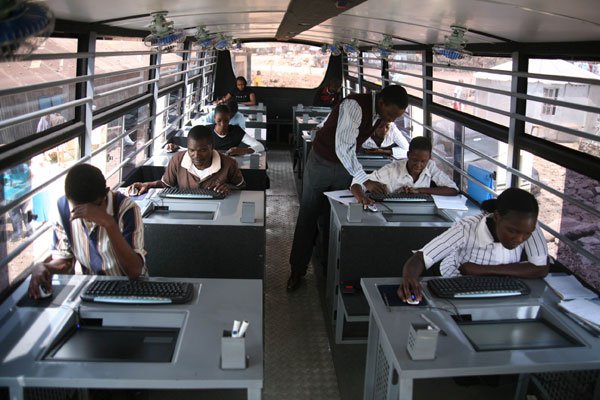Craft Silicon Ltd., a Nairobi-based ICT solutions company, has initiated an innovative program through its Craft Silicon Foundation Center. This program aims at reducing the digital gap in not just the Nairobi upper and middle class, but also between men and women.


The bus is fitted with a customized server, education courseware, internet connection, printers, scanners, and they are all powered by solar. The bus has four photovoltaic cell fitted on its roof to harness sunlight, and the energy is stored in the bus’s four batteries.
Craft Silicon Foundation seeks to bridge the digital gap between the urban poor and wealthy, while at the same time ensure both genders are equally empowered. Craft Silicon Ltd and the Foundation were founded and are being run by Priya and Kamal Budhabhatti, an India-Kenyan couple in Nairobi.
“The project’s aim is to promote universal computer literacy among the youths and young girls in the slums and enable them use computer knowledge and skills to seize opportunities that will make them self-reliant. The program also aims at promoting development in these areas,” said Priya.
“We have so far trained 6,000 youths, most of them girls from Kawangware, Kibera, Huruma, and Mukuru kwa Nyayo. Our biggest challenge is that we only have one bus, which limits our effort to reach more young people. The turn up has been very huge, and I think we couldn’t have reached such a number had we been relying on regular classrooms.”
The Craft Silicon Foundation Bus ICT Classes
The Foundation recruits news students into the ICT classes through a street vetting program. The program mainly seeks youths from poor backgrounds; especially those from slum neighborhoods of Nairobi. After their recruitment, the students’ first stage of learning entails an introduction to basic computer knowledge. They then proceed to the second stage, where they are moved to the Craft Silicon Foundation Center located in Westlands. The second stage entails lessons on advanced ICT skills. The third and final stage, the students learn about communication, business, and entrepreneurial skills. The foundation aim is to create self-employed, job creators out of the students.
After successful completion of their studies, the organization will also try to match some of the students with jobs opening in their partner companies. They also support the best students to further their ICT studies to more advanced levels.
The State of Digital Gap Globally
Digital Gap is a technical word used to describe the widening gap in technical skills between the people with access to ICT and those that don’t. In a nutshell, this is the difference in knowledge and opportunities between people with access to computers and the internet, and those without the access.
While there is a digital gap between the developed and developing countries; the gap is bigger within the developing countries themselves. In particular between the upper class and lower class citizens; it gets even wider when looking at the digital divide between men and women from low-income neighborhoods.
Back in October 2015, Web Foundation tabled a report on a study it did on the state of digital literacy in developing countries. The research unearthed that while digital literacy is quite low in developing countries compared to developed countries. The digital gap between men and women was astoundingly big; in particular among the low-income neighborhoods. The research found out that only 37% of women used the internet, a small figure compared to the 59% of men.
Although access to the internet does not necessarily mean better job opportunities and higher incomes; experts believe, however, it does usher in a new platform for more choices. With that in mind, it is quite obvious that women are mostly missing out on the new opportunities that come with the ICT skills.



